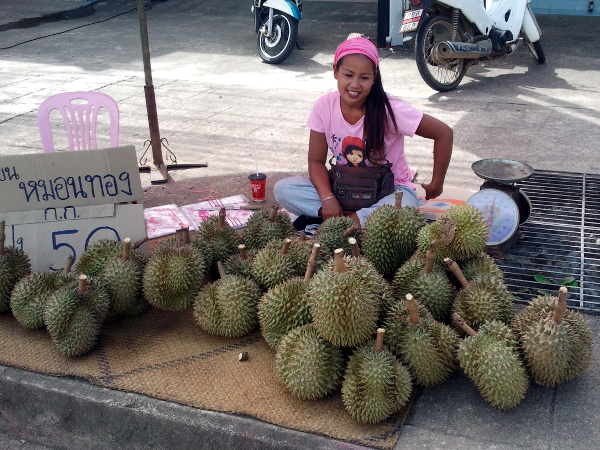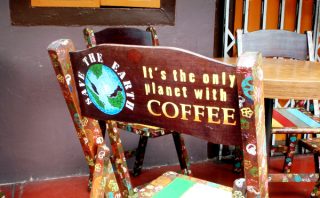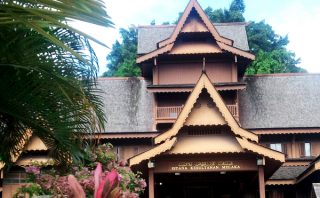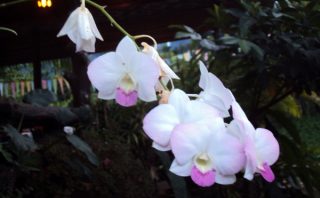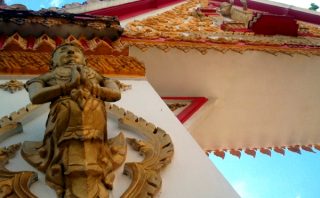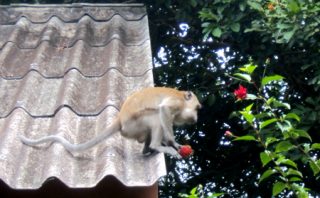The Thai islands we’ve seen and the one we visited so far jut out of the sea, jungle covered, rugged, and steep. But not Koh Phra Thong. This island is almost entirely flat. The far east side is covered in mangroves. The center and west are covered with savanna grasslands and scrub. The beach on the west side runs almost unbroken the length of the island.
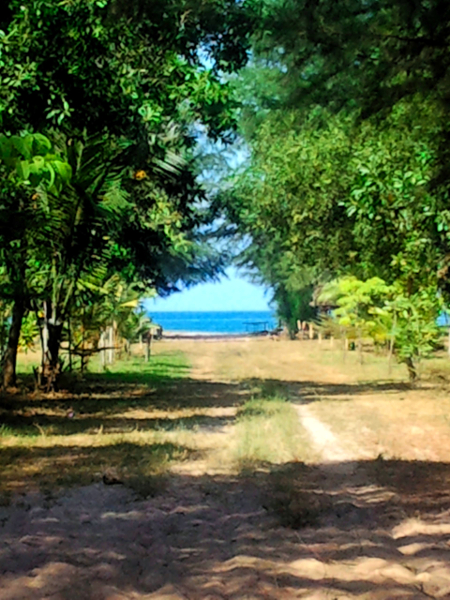
Koh Phra Thong is remote, secluded, and rustic. Arranging boat transport to go the 10km from the mainland to the island takes effort. The beach is nearly undeveloped. There are only three villages on the island. A little cashew farming, fishing, and tourism make up the economy. Lodging options for travelers consist of a village home stay, one upscale resort, and three bungalow resorts. This island is definitely off the beaten track.
After breakfast I take off on the track to the beach a short hundred meters or so away. The track passes another bungalow site. I think it’s called Phra Thong Nature Resort. Nothing much going on there. Nothing going on at the beach either. As far as I can see no one else is here. Excellent. Lori shows up after awhile. She’s been reading or something. We swim, collect seashells, swim, beach walk swim, and I get a sunburn. Had to happen. Always does at some point.
To the south on the next bay over, there’s another bungalow resort. This one is called Horizon Beach Bungalows. Doesn’t seem like much going on there either. Blue Guru Diving’s shop is further along. I get the scoop from the guys on snorkeling spots and renting a sea kayak. Sounds like something for tomorrow. I need to get out of the sun so we head back to Mr. Chuoi’s for lunch and bungalow lounging.

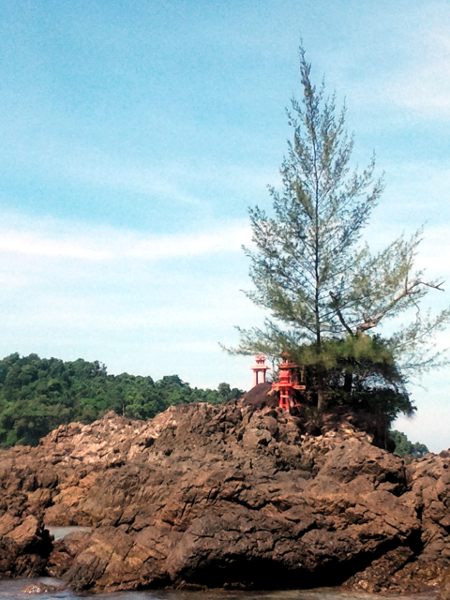
Mr. Chuoi Bar and Hut
Mr. Chuoi is an affable guy and his staff are friendly as well. Mr. Chuoi Bar and Hut is just what the name says. There’s a bar and restaurant, and about a dozen huts. You can get mixed drinks, but mostly the bar has beer. Cold beer. The restaurant serves standard Thai tourist fare like banana or pineapple pancakes for breakfast, soups, curries, various stir fry with rice, various stir fry with noodles, cashew nut chicken, etc. The meals are quite tasty and portions quite ample.
The huts are raised on stilts, have palm thatched rooves, and appear to be built using traditional techniques. Our hut has a small veranda out front for lounging that takes a minor acrobatic move to get on to it. There’s a comfortable bed, a mosquito net in good condition over it, and a light and fan for in the evening until the power goes out. The bathroom has walls but no ceiling. There’s a shower (hose and nozzle), basin and faucet, western style toilet that you flush by pouring a bucket of water in it, and a bidet instead of toilet paper (also fondly called a bum gun). The water is not heated but air temperature water here is not what you’d call cold. What more could a traveler want?
Mr. Chuoi’s huts are said to be styled after the houses of the Moken people. The Moken are also known as Sea Gypsies. The sea gypsies are a nomadic people who traditionally spend much of their lives on boats in the seas off of Burma, Thailand, Malaysia and Borneo. Thailand’s Moken inhabit a few settlements on islands in the Andaman Sea. Later I read a couple articles about the Moken: Koh Lao – Moken Village and The Sea Gypsies of Surin Island.
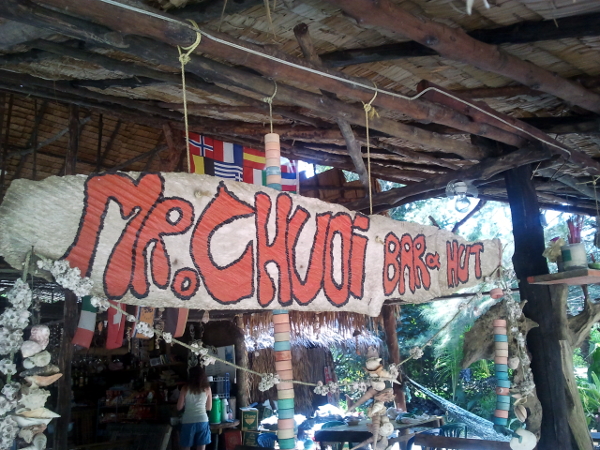

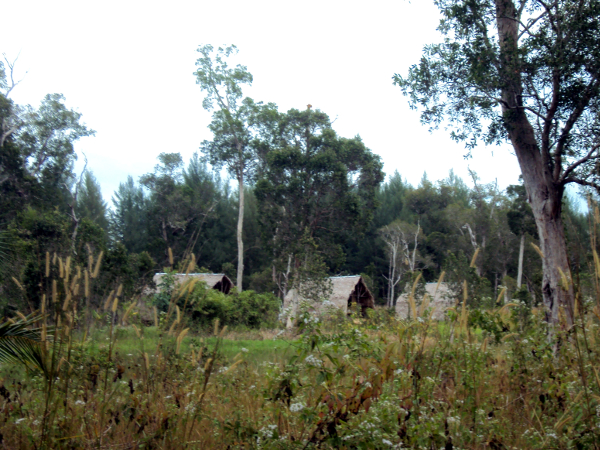
Next Day
We rent a kayak from Blue Guru. The tide is in so we start out paddling up the nearby estuary. We’ve heard there are lots of birds and monkeys along the banks. We see a couple birds but no monkeys. The estuary starts to get pretty overgrown. Bushwhack paddling isn’t so much fun so we turn around and head back to the bay. We paddle out and about the small island in the bay, explore the beach there, swim a little, and then head back to Blue Guru.
Although we’re told people saw sea turtles while snorkeling yesterday, we’re not feeling up to it. I don’t want to make my sunburn any worse than it is. We walk to the Golden Buddha for lunch and some internet wi-fi access instead. The meal is delicious and seems like more authentic Thai than the typical tourist food. For instance, my soup has wide rice noodles and various, unknown greens including some I think might be ferns.
We visit Golden Buddha’s small gift shop after lunch and I buy a sarong to cover my sunburned legs. The sarong is a batik made by the villagers at Baan Lions. I look good in a sarong.

The beach houses at Golden Buddha are impressive but they apparently didn’t hold up during the 2004 Boxing Day Tsunami. During the tsunami, some people scrambled up Monkey Hill, the highest point on the island, near Golden Buddha. Others took refuge on the second floor of Golden Buddha’s restaurant building. The ones in the restaurant didn’t make it. Mr. Chuoi’s place was pretty much wiped out. He said he survived by climbing up a palm tree and holding on tight.
Mr. Chuoi hosts a buffet for dinner. Good food. Afterwards, we go to the beach for a swim under the stars.
Next To Last Day
We take a stroll inland to see the Koh Phra Thong savanna. It gets hot as soon as we’re away from the beach breezes. Too hot. We don’t explore for long. Back to the beach for swimming and an afternoon of lounging.

Last Day
That remote thing. You need to bring cash with you to cover all you expenses on remote islands. There are no ATMs. You can use a credit or debit card at Golden Buddha for a fee, which we did for our lunch there. But that’s the only place on Koh Phra Thong you can use plastic. So, it’s important to keep track of your spending. The staff write down your meals and beverages as you go. You can add that up and add in your room and boat transport fees yourself each day. But who wants to do that while on island time? We try to keep a rough running count in our heads. That doesn’t work so well. There’s a little nervous tension as we wait for Mr. Chuoi to add up our bill. I look it over. I show him an error. It’s in his favor. He’s appreciative. We have just enough if Mr. Chuoi will accept US dollars. We have some twenties in the bottom of Lori’s pack. He takes dollars. He calls a friend to get the exchange rate.
We share the ride on Mr. Chuoi’s saleng to Baan Lions and the longtail back to Khuraburi with a couple and their adult son who are from Seattle, Washington. We also share a songthaew with them from the pier to the bus station.
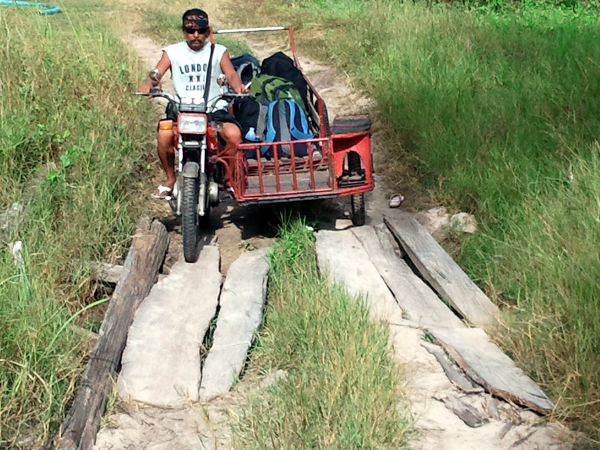
I speed walk the few blocks from the bus station to a 7-Eleven that has an ATM. There’s a lady selling durian outside the store. I give her product a wide berth. The odor turns my stomach. But I do stop long enough to get her okay for a photo. The bus is there when I get back.
The bus stops in Takua Pau. We get some lunch at the street stalls while we wait for our connection east back to Surat Thani. Meat balls on a stick with hot dipping sauce from one stall, and noodle soup from another.
In Surat Thani, we are immediately pounced on by taxi drivers. I wish I knew how to say “slow down” in Thai. It would be nice to get off the bus and get my bearings before discussing a taxi. We arrange for a songthaew to take us to our hotel, which is out of town and near the airport.
We realize it’s New Year’s eve and think maybe we should go out. The hotel is on a busy highway. We walk along the shoulder of the road hoping to find a restaurant and spend the evening with locals. Maybe not a smart idea — two white foreigners walking beside a busy highway at night. After a half hour, we haven’t found a restaurant so we turn around and return to the hotel where we have a very nice dinner at the hotel restaurant instead. We watch a few fireworks from our hotel room window but don’t manage to stay awake to welcome in 2013.
In the morning, the hotel arranges a taxi cab to take us to the airport. By early afternoon, we are back home in Kuala Lumpur.
